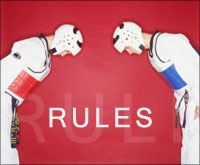

First, Taekwondo is the right way of using Tae and
Kwon 'fists and feet,' or all the parts of the body that
are represented by fists and feet. Second, it is a way
to control or calm down fights and keep the peace.
This concept comes from the meaning of Tae Kwon 'to
put fists under control' [or 'to step on fists'].
Thus Taekwondo means "the right way of using all parts
of the body to stop fights and help to build a better and
more peaceful world."
Taekwondo has been developing with the 5000-yearlong history of Korea, being called by several different names in the course. In Korea, Taekwondo began as a defense martial art called "Subak" or "Taekkyon," and developed as a way of training body and mind in the ancient kingdom of Koguryo, under the name of "Sunbae." In the Shilla period, it had become the backbone of Hwarangdo that aimed at producing leaders of the country.
Taekwondo today is similar to the martial arts in other Oriental countries and shares some
features with them, because in the course of its evolution it has gained many different styles
that existed in the martial arts of the countries surrounding Korea, like Japan and China.
But Taekwondo is very different from many
such oriental martial arts. First, physically it is
very dynamic with active movements that include
a mirage of foot skills. Second, the principle physical
movements are in simpatico with that of the mind and life
as a whole.Third, it possesses dynamic poses from another perspective.
Taekwondo can be characterized by unity: the unity of body, mind, and life, and the unity of the pose ["poomsae"] and confrontation, and cracking down. When you do Taekwondo, you should make your mind peaceful and synchronize your mind with your movements, and extend this harmony to your life and society.
This is how in Taekwondo the principle of physical movements, the principle of mind training, and the principle of life become one and the same. On the other hand, the right poomsae lead to the right confrontation, which will eventually produce great destructive power.
The Koreans adopted Taekwondo from China , during the T'ang Dynasty. Koera was divided into three kingdoms: Paekche, Koguryo, and Silla. The Chinese wanted control over them.
They then decided to help the latter conquer the other two and unite Korea. The Silla were chosen because they were the smallest and least civilized, therefore the easiest to control. The Chinese Tang Dynasty assisted by sending soldiersand training the Silla warriors in warfare and martial arts.They called their art Tang Soo Do.
That name still exists it means hand of the Tang. The Koreans wanted to change that name to reflect on their country and not the Chinese, so they changed it to Tae Kyon. The sons of the nobility and the elite warrios were called Hwarang (meaning flowering manhood), and were later taught the highest level or martial arts, known as Hwarang Do (the way of the Hwarang), while commoners and soldiers learned basic martial arts, known as Subak or Subak Do.
The names of the arts in Korea constantly changed, until the Japanese invaded them and banned any practice of martial arts. That action revived the declining interest in the fighting arts, and practice was achieved in secrecy. Some eventraveled to Japan and China and learned different arts, specifically Karate Do and Kung Fu.
When the Japanese were finally expelled, all the Korean Masters tried to unite all their arts. They decided to unify the martial arts under one name, and Taekwondo was chosen, due to its accurate description of the skills taught (the way of hand and foot), and its similarity to one of the original names (Tae Kyon).
Hapkido was the only Korean art that refused to be included in this union, they remained independent. The people were divided during and after the Korean War. The martial art schools opposed each other, and the masters resumed teaching their art under different old names (such as, Tang Soo Do, Hwarang Do, Tae Kyon) so as not to associate themselves with organizations affiliated with their enemies.

